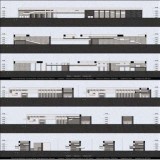Supervisor:
Urban Design and Planning
Architectural Design
2010
The present dissertation is a study on the urban area of Peiraios Avenue and refers to the creation of four public spaces in a series of sites (Faliron area, Moshato area, Tauros area, Gazi area). Peiraios Avenue constitutes the main road connection between downtown Athens and the port area of Peiraias, as from the early antiquity it connected the ancient Athenian “asty” with its seaport. Moreover it was surrounded from the “Makra Teixi”, the Long Walls Fortification of the city, strengthening its significance as an unbreakable road axis in the byway of years.
In the newer development of Athens Urban Area, Peiraios Avenue was transformed into an industrial and merchant axis, hosting a plethora of factories and warehouses on both sides of the road, while on its sides urban neighborhoods of different character start to appear and develop. The diversity of urban landscape around Peiraios Avenue is reflected in an abundance of events and activities in various sites: at the beginning of the Avenue at Peiraias an open market takes place every Sunday, at the Texnopolis area the rag collectors of Athens organize an open bazaar, while a series of malls, office buildings, culture facilities and organized housing areas give the tone for the urban areas in between the edges of the avenue.
Taking advantage of the variety of activities per area, the proposed constructions have a double identity: both as passages (people’s crossings due to the heavy traffic of the avenue), as well as sites for the accommodation of local public activities. More specifically they consist of a group of open and closed spaces, colonnades, enclosed courtyards and stairways, which create small protected neighborhoods for future users of the sites. In each of the four sites the proposed constructions play the role of a modern “Wall”, in remembrance of the ancient Wall ruins, which do not however separate or seclude, but instead connect the opposite urban areas and facilitate the passage of residents, breaking effectively the continuous and rigid limit of the avenue.
At the Faliron area the construction proposes the accommodation of a substantial part of the Sunday’s open market, at the Moshato area the operation of a small open market for fruits and vegetables in contact with the neighboring main Athens fruit market, at the Tauros area the creation of a meeting and trading place for local residents, while at the Gazi area the proposed construction is a new small square for the rag collectors association. In any case, the existence of large open spaces, with minimum building infrastructure, makes it easier for the users to take full advantage of the interventions, based on their uses and particular needs.
As part of the dissertation research, a successive photographic impression of the avenue and its neighboring urban areas was created, followed by the urban analysis of the individual sites of the project, and finally by the creation of sketches, drawings, models and depictions of the proposed constructions, that attribute the philosophy of the intervention in total.
